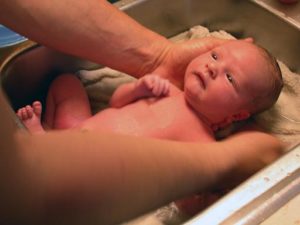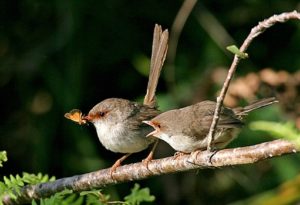
A newborn remembers sensations from the womb. For one bird, prenatal memory is life-saving.

Image: Fledgeling fairy wren calling to mother, who holds its next meal.
Photo attribution: By Nevil Lazarus (Nevil Lazarus via Cas Liber) [CC BY 3.0 (http://creativecommons.org/licenses/by/3.0)], via Wikimedia Commons
Scientists tell us that a human baby becomes able to hear in the last trimester of pregnancy, 3 months before birth. For the Australian bird known as the Superb Fairy-wren, the last trimester is about 5 days before eggs hatch, and 10 days after laying the eggs.
The Superb Fairy-wren sings a password to her unhatched chicks, about every 10 minutes from the edge of the nest, during those last 5 days, and then sings it to them no more, once they start hatching.
This article explains how the prenatally-taught password, though it doesn’t always save her chicks, enables the Superb Fairy-wren to avoid feeding a brood-parasite, the cuckoo bird.
Imagine a mama wren hovering above her nest. The chick below is crying out for food. The mama listens. She keeps listening. The chick is obviously hungry; the mama has a mash of berries ready, but … she doesn’t land. Instead, after a few more beats, she turns and — suddenly — vanishes. She doesn’t come back. Ever. The baby starves.
What just happened?
The mother has just made a horrible discovery. A few days earlier she had a couple of eggs (not yet hatched) in that nest. While she was out foraging, a sneaky neighbor snuck over and dropped an extra egg of her own into the nest. This new egg wasn’t invited. It wasn’t even a wren egg. It belonged to a Horsfield’s bronze-cuckoo, an animal that biologists call a “brood parasite” — meaning the cuckoo tricks other birds into raising her kids.
Mama wrens don’t see all that well. Cuckoo eggs and wren eggs look similar enough that wrens figure, well, if they’re in my nest, they must be mine. So the cuckoo switcheroo can work. The dastardly part is that cuckoo eggs are programmed to hatch extra quickly, so when the baby cuckoo emerges, it can sometimes be the first viable bird, free to move around and free to then push the other unhatched eggs out of the nest, to their death …
… making itself the sole (and, therefore, a very well-fed) surviving chick. So yes, these baby cuckoos are killers. Yes, they are imposters, but no, they don’t always get away with it.
That’s where the names [passwords] come in.
Biologist Diane Colombelli-Negrel, from Flinders University in South Australia, discovered that Superb Fairy-wren moms have a way to detect an imposter. When they lay their eggs, they wait nine days, and then park themselves by the eggs and start singing. They will sing and sing the same tune every four minutes, over and over for a week, and the chicks inside those eggs not only hear the tune, they commit it to memory.
Scientists call this an “incubation call” and Colombelli-Negrel found that these songs contain a special note that is, in effect, a familial password. When the embryonic chicks hatch and then begin to cry out for food, they will include that note in their begging calls, so the mother knows, “Ok, that one is mine.”
So why don’t the Horsfield’s bronze cuckoo chicks know that note?
Because they arrive late. Their mothers slip them into the nest at the very last moment — about two to three days before all the eggs hatch. Yes, the interlopers are speedy hatchers and can sometimes eliminate their foster brothers and sisters — but they haven’t had enough time to learn the password. Three days aren’t enough.
So now, when the Superb Fairy-wren comes by and sees a bunch of chicks (or just one biggish baby) and says, “Whaddaya say, little one?” the imposter doesn’t know the code.
Mama notices and decides, “You’re not my baby.”
To see the rest of this article by Robert Krulwich, including the video of the cuckoo nestling pushing eggs out of the nest, see this link.
An immediate outcome of this 2012 study was confirmation that “some seemingly innate traits are the result of experience during the embryonic stages.”
More far-reaching outcomes were anticipated thusly:
Birds were the founding model system for our current understanding of neural plasticity in adults, including humans (e.g., [28]; see also [29]). This initial work on neural plasticity in birds was followed by many studies on neural pathways that underpin muscle and thought control in rats [30], evidence for neural/robotic interface in monkeys [31], and most recently neural control of thought to initiate robotic arms to assist humans [32]. Our results here on prenatal learning in wrens highlight the point that birds are also an excellent model system in which to study prenatal sensory and cognitive development and their underlying neural organization, because embryonic developmental stages can be easily observed and stimulated in the egg (see also [33]). Model systems that use noninvasive approaches (such as MRI) to study embryonic neural and cognitive development are likely to stimulate new fields of inquiry over the coming decades.
The link to the original research paper for this 2012 study by Colombelli-Negrel is found here.
In the above 2012 Superb Fairy-wren study, training of wren embryos was monitored with audiovisual devices.
Two studies of Superb Fairy-wrens are reported in this article curation, the one reported above, from 2012 and one from 2014, reported below. Each study utilized different monitoring techniques.
The above-referenced study utilized audiovisual devices for gathering of data.
Click next page to see the results of a follow-up study using a heart monitor on embryos of the Superb Fairy-wren, for which the outcome was published in October, 2014.



